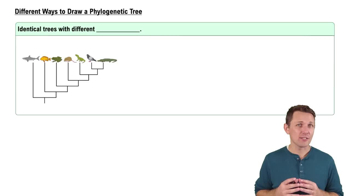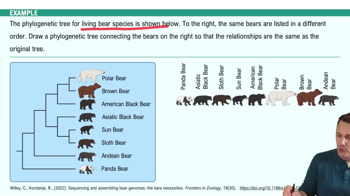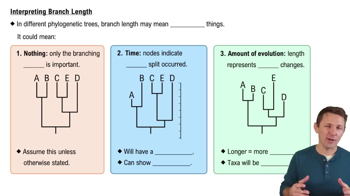Table of contents
- 1. Introduction to Biology2h 40m
- 2. Chemistry3h 40m
- 3. Water1h 26m
- 4. Biomolecules2h 23m
- 5. Cell Components2h 26m
- 6. The Membrane2h 31m
- 7. Energy and Metabolism2h 0m
- 8. Respiration2h 40m
- 9. Photosynthesis2h 49m
- 10. Cell Signaling59m
- 11. Cell Division2h 47m
- 12. Meiosis2h 0m
- 13. Mendelian Genetics4h 41m
- Introduction to Mendel's Experiments7m
- Genotype vs. Phenotype17m
- Punnett Squares13m
- Mendel's Experiments26m
- Mendel's Laws18m
- Monohybrid Crosses16m
- Test Crosses14m
- Dihybrid Crosses20m
- Punnett Square Probability26m
- Incomplete Dominance vs. Codominance20m
- Epistasis7m
- Non-Mendelian Genetics12m
- Pedigrees6m
- Autosomal Inheritance21m
- Sex-Linked Inheritance43m
- X-Inactivation9m
- 14. DNA Synthesis2h 27m
- 15. Gene Expression3h 20m
- 16. Regulation of Expression3h 31m
- Introduction to Regulation of Gene Expression13m
- Prokaryotic Gene Regulation via Operons27m
- The Lac Operon21m
- Glucose's Impact on Lac Operon25m
- The Trp Operon20m
- Review of the Lac Operon & Trp Operon11m
- Introduction to Eukaryotic Gene Regulation9m
- Eukaryotic Chromatin Modifications16m
- Eukaryotic Transcriptional Control22m
- Eukaryotic Post-Transcriptional Regulation28m
- Eukaryotic Post-Translational Regulation13m
- 17. Viruses37m
- 18. Biotechnology2h 58m
- 19. Genomics17m
- 20. Development1h 5m
- 21. Evolution3h 1m
- 22. Evolution of Populations3h 52m
- 23. Speciation1h 37m
- 24. History of Life on Earth2h 6m
- 25. Phylogeny2h 31m
- 26. Prokaryotes4h 59m
- 27. Protists1h 12m
- 28. Plants1h 22m
- 29. Fungi36m
- 30. Overview of Animals34m
- 31. Invertebrates1h 2m
- 32. Vertebrates50m
- 33. Plant Anatomy1h 3m
- 34. Vascular Plant Transport2m
- 35. Soil37m
- 36. Plant Reproduction47m
- 37. Plant Sensation and Response1h 9m
- 38. Animal Form and Function1h 19m
- 39. Digestive System10m
- 40. Circulatory System1h 57m
- 41. Immune System1h 12m
- 42. Osmoregulation and Excretion50m
- 43. Endocrine System4m
- 44. Animal Reproduction2m
- 45. Nervous System55m
- 46. Sensory Systems46m
- 47. Muscle Systems23m
- 48. Ecology3h 11m
- Introduction to Ecology20m
- Biogeography14m
- Earth's Climate Patterns50m
- Introduction to Terrestrial Biomes10m
- Terrestrial Biomes: Near Equator13m
- Terrestrial Biomes: Temperate Regions10m
- Terrestrial Biomes: Northern Regions15m
- Introduction to Aquatic Biomes27m
- Freshwater Aquatic Biomes14m
- Marine Aquatic Biomes13m
- 49. Animal Behavior28m
- 50. Population Ecology3h 41m
- Introduction to Population Ecology28m
- Population Sampling Methods23m
- Life History12m
- Population Demography17m
- Factors Limiting Population Growth14m
- Introduction to Population Growth Models22m
- Linear Population Growth6m
- Exponential Population Growth29m
- Logistic Population Growth32m
- r/K Selection10m
- The Human Population22m
- 51. Community Ecology2h 46m
- Introduction to Community Ecology2m
- Introduction to Community Interactions9m
- Community Interactions: Competition (-/-)38m
- Community Interactions: Exploitation (+/-)23m
- Community Interactions: Mutualism (+/+) & Commensalism (+/0)9m
- Community Structure35m
- Community Dynamics26m
- Geographic Impact on Communities21m
- 52. Ecosystems2h 36m
- 53. Conservation Biology24m
25. Phylogeny
Phylogeny
Problem 15
Textbook Question
Textbook QuestionWhat types of molecular comparisons are used to determine the very early branching of the tree of life? Explain.
 Verified step by step guidance
Verified step by step guidance1
Identify the types of molecules that can be compared across different species. Common molecules used in these comparisons include DNA, RNA, and proteins.
Understand the importance of highly conserved genes, which are genes that have remained relatively unchanged throughout evolution. These genes are ideal for studying early evolutionary relationships because they are present in a wide range of organisms.
Examine ribosomal RNA (rRNA) sequences, which are often used for studying early divergences in the tree of life. rRNA plays a crucial role in protein synthesis in all living organisms and has regions that are highly conserved and some that are variable.
Consider the use of mitochondrial DNA (mtDNA) and chloroplast DNA (cpDNA) for molecular comparisons. These organelle genomes are inherited maternally in most organisms and can provide insights into the maternal lineage and evolutionary history.
Explore the application of bioinformatics tools and phylogenetic analysis to compare these molecular sequences across different organisms. This analysis helps in constructing a phylogenetic tree that represents the evolutionary relationships and helps in understanding the early branching patterns of the tree of life.
Recommended similar problem, with video answer:
 Verified Solution
Verified SolutionThis video solution was recommended by our tutors as helpful for the problem above
Video duration:
2mPlay a video:
Was this helpful?
Key Concepts
Here are the essential concepts you must grasp in order to answer the question correctly.
Molecular Phylogenetics
Molecular phylogenetics is the study of evolutionary relationships among biological entities, often using molecular data such as DNA, RNA, or protein sequences. By comparing these molecular sequences across different organisms, scientists can infer how closely related they are and construct a 'tree of life' that illustrates these relationships. This approach is particularly useful for understanding early branching events in evolution.
Recommended video:

The Molecular Clock
Genetic Markers
Genetic markers are specific sequences in the genome that can be used to identify and compare different species or populations. These markers can include single nucleotide polymorphisms (SNPs), insertions, deletions, or entire genes. By analyzing these markers, researchers can trace lineage and divergence, providing insights into the early branches of the tree of life.
Recommended video:
Guided course

Genetic Code
Molecular Clock
The molecular clock is a technique that uses the mutation rates of biomolecules to estimate the time of divergence between species. By assuming a constant rate of mutation, scientists can calculate when two species last shared a common ancestor. This method is crucial for placing early branching events in the context of evolutionary time, helping to clarify the relationships among the earliest forms of life.
Recommended video:

The Molecular Clock

 7:10m
7:10mWatch next
Master Reading a Phylogenetic Tree with a bite sized video explanation from Bruce Bryan
Start learningRelated Videos
Related Practice





















